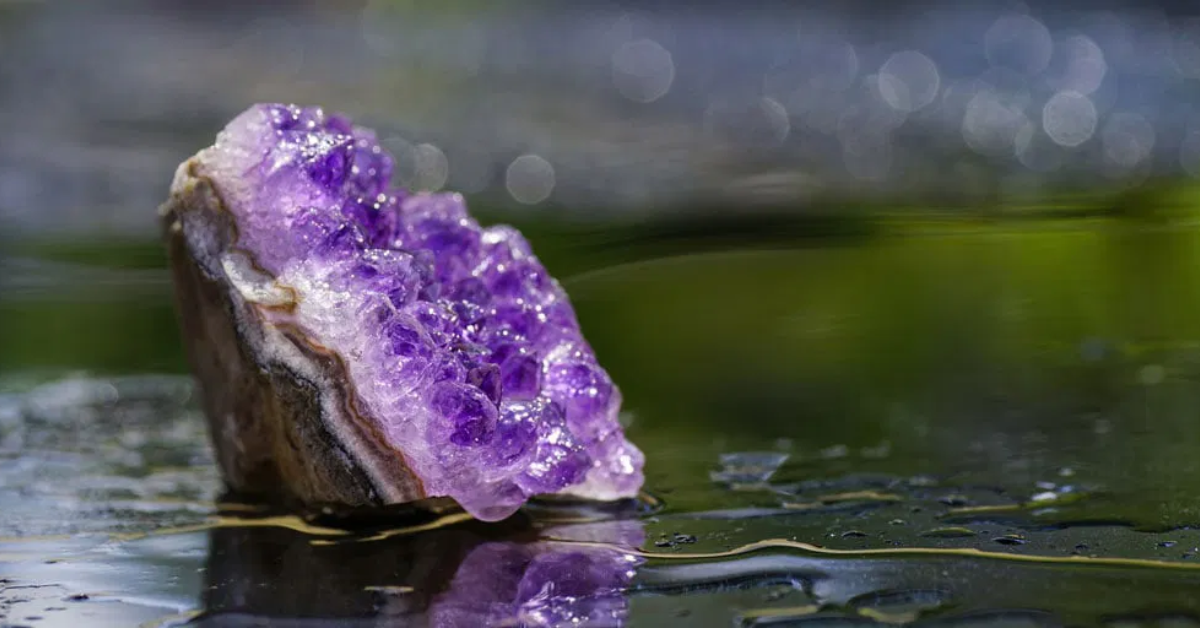Amethyst is one of the most beloved gemstones in the world, admired for its vibrant purple hue and calming energy. Whether worn as amethyst jewellery or kept as a raw crystal, it’s a stone many people treasure both spiritually and aesthetically. But one of the most common questions asked by crystal owners is: Can amethyst go in water? This blog explores that question and more—offering both practical advice and essential knowledge so you can take care of your amethyst stone properly.
If you’ve ever wondered whether water affects amethysts, this guide gives you the honest truth—no fluff, just exactly what you need to know to protect your crystal.
Is Amethyst Safe in Water?
Let’s start with the short answer: Yes, amethyst can go in water—but only under certain conditions.
Amethyst ranks 7 on the Mohs scale of mineral hardness. This means it is relatively hard and can withstand light contact with water, such as gentle cleaning or ritual rinsing. However, there are risks if amethysts are left submerged for extended periods or exposed to certain types of water.
Water won’t immediately destroy your crystal, but it may dull its shine or weaken its structure over time, especially if the water contains salt, chemicals, or minerals.
Does Amethyst Lose Colour in Water?

Yes, in some cases, amethyst stones may fade or become less vibrant when exposed to water over time. This especially applies when the water exposure is combined with:
-
Sunlight: UV rays can fade amethyst’s natural colour, and if the stone is wet, the effect is even more intense.
-
Heat: Warm or hot water can encourage fading, especially in heat-treated amethysts.
-
Hard Water: If your tap water has high mineral content, it may leave deposits on your crystal, causing dullness or surface changes.
For this reason, regular or careless exposure to water is not recommended if you want to preserve the deep purple of your amethyst jewellery or raw stone.
Can Water or Liquids Damage Amethyst?
Although amethyst is relatively sturdy, water can damage it in the following ways:
-
Surface erosion – Extended soaking may slowly erode the crystal’s outer layer.
-
Inclusions and fractures – Water can seep into tiny cracks or inclusions, expanding them over time.
-
Discolouration – As mentioned earlier, mineral-heavy water or chemical exposure can cause fading or staining.
-
Metal settings – If your amethyst jewellery is set in silver or another metal, water may tarnish or corrode the setting even if the stone remains intact.
So while short, gentle exposure is generally safe, you should avoid long or frequent contact with water if you wish to keep your amethyst in top condition.
5 Amazing Ways to Keep Amethyst Safe in Water

If you still want to use water in your spiritual practices or cleaning routine, here are five effective and safe ways to do it without harming your amethyst:
1. Use Distilled Water Only
Tap water contains minerals and chemicals that may harm your amethyst stone. Instead, use distilled or filtered water. It’s gentle and reduces the risk of surface deposits or discolouration.
2. Keep Water Exposure Short
A quick rinse for cleaning purposes or light ritual use is fine. Keep the exposure under a minute and dry your amethyst immediately with a soft cloth.
3. Avoid Sunlight After Rinsing
Never leave your amethyst in the sun to dry. Water combined with sunlight can accelerate colour fading. Dry it indoors in a shaded area.
4. Protect Jewellery Settings
If you’re cleaning amethyst jewellery, make sure the metal parts are water-safe. Silver, for example, tarnishes quickly when wet. You may want to clean the stone separately and polish the metal using a dry cloth.
5. Use Indirect Methods for Energy Cleansing
If you’re cleansing your amethyst energetically, you don’t need to soak it in water. Try placing it near a bowl of water instead, or use sound cleansing, incense, or moonlight to avoid water damage altogether.
Conclusion
So, can amethyst go in water? The answer is yes—but with caution. While a small splash won’t hurt, regular or prolonged exposure can lead to dullness, colour fading, or even structural weakening over time. Whether you're caring for a precious piece of amethyst jewellery or a raw stone used for spiritual practices, following safe water guidelines is essential to protect your crystal.
Use distilled water, limit exposure, and avoid sunlight immediately after rinsing. And remember—there are plenty of non-liquid ways to cleanse or recharge your amethyst if you’re unsure.
With the right care, your amethyst can remain vibrant, powerful and beautiful for years to come.
Frequently Asked Questions
Q: Can you shower with amethyst jewellery?
It’s not recommended. Shampoo, conditioner, and hot water may dull or damage both the amethyst stone and the metal setting over time.
Q: Can amethyst be placed in salt water?
Avoid it. Salt water is abrasive and can lead to surface damage or internal cracks in your amethyst.
Q: How do I clean my amethyst safely?
Use a soft cloth and a quick rinse with distilled water. Avoid harsh chemicals or ultrasonic cleaners.
Q: Can I leave my amethyst in water overnight?
No. Extended soaking increases the risk of colour fading and structural damage.
Q: Is moon water safe for amethyst?
Yes, as long as the amethyst is not left in direct moonlight or soaking too long. Use clean, distilled moon water and pat dry immediately.
